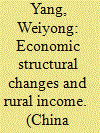| Srl | Item |
| 1 |
ID:
092543


|
|
|
|
|
| Publication |
2009.
|
| Summary/Abstract |
During the reform period, the Chinese rural economy has experienced deep structural changes: cropping adjustment, agro-forestry adjustment and agro-industrial adjustment. At the same time, rural per capita income rose sharply despite some fluctuations. Using a panel data of 29 provinces from 1982 to 2001, effects of these structural changes upon both income level and income instability are assessed. The empirical results show that crop adjustment and agro-industrial adjustment can increase rural income and reduce income instability, while agro-forestry adjustment reduces both income and its instability, as a risk-management strategy.
|
|
|
|
|
|
|
|
|
|
|
|
|
|
|
|
| 2 |
ID:
068889


|
|
|
| 3 |
ID:
100755


|
|
|
|
|
| Publication |
2010.
|
| Summary/Abstract |
Economic reforms in rural China have brought opportunities to diversify both within-farm activities and off-farm activities. Participation in these activities plays an important role in increasing rural households' income. This paper analyzes the factors that drive rural households and individuals in their income-source diversification choices in a Northern China township. At the household level, we distinguish three types of diversification as opposed to grain production only: within-farm (non-grain production) activities, local off-farm activities, and migration. We find that land availability stimulates on-farm diversification. Local off-farm activities are mostly driven by households' asset positions and working resources, while migration decisions strongly depend on the household size and composition. At the individual level, we analyze the determinants of participation in three different types of jobs as compared to agricultural work: local off-farm employment, local self-employment and migration. We find a clear gender and age bias in access to off-farm activities that are mostly undertaken by male and by young people. The households' asset positions as well as village networks are found to strongly affect participation in off-farm activities.
|
|
|
|
|
|
|
|
|
|
|
|
|
|
|
|